June 10-14, 2010 | Intelligence and Terrorism Information Center, part 1 and part 2
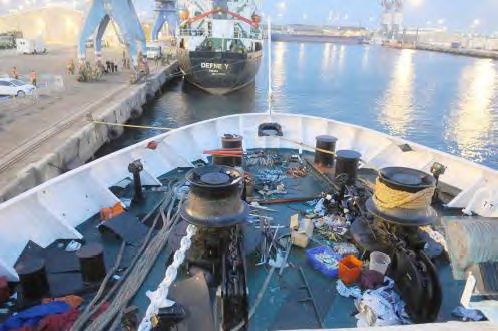
The prow of the Mavi Marmara, the flagship of the IHH flotilla, with some of the weapons found on board the ship.
Additional information about the violent intentions of the IHH operatives during the voyage of the Mavi Marmara and the weapons found in their possession[1]
Overview
1. Statements made by IDF soldiers, pictures taken aboard the Mavi Marmara, statements from passengers, information found in files on laptops seized from the ship and statements made by passengers to the media after their release, all prove that the violence employed against the IDF on board the ship was not spontaneous but rather a premeditated operation. The operation was organized beforehand by IHH and implemented by a hard core of 40 violent operatives who were taken on board specifically for the purpose. This bulletin provides an updated picture based on recently acquired information.
2. The hard core of 40 IHH operatives boarded the ship in Istanbul. They remained on the upper deck while the other passengers (of whom there were about 500 on board) received orders to remain below decks (The IHH leader ordered “Turks, upper deck, Arabs, below decks.”).
3. The 40 IHH operatives joined the ship in Istanbul without a security check. Most of them wore stickers reading “Security Protection” (khares amni). They also prepared in advance designated equipment and cold weapons for a possible IDF takeover of the boat (for example, they brought metal cutting disks to cut the ship’s railings). The IHH operatives were commanded by organization’s leader, Bülent Yildirim, who organized the fighters, briefed them before the confrontation with the IDF forces and instructed them to use violence. The media reported that some operatives specifically stated that they wanted or were willing to die as martyrs (shaheeds).
4. According to the minutes of a meeting of the flotilla leadership which took place on May 16, in which IHH played a major role, the possible scenarios in which the flotilla passengers participated did not include a violent confrontation with the IDF (an analysis of the minutes will be published separately). Moreover, other organizations participating in the flotilla, such as Free Gaza, had their activists sign pledges that they would not engage in physical or verbal violence against IDF soldiers. All of the above create the impression that IHH fooled some of the other organizations, hiding its true intentions to employ severe violence.
Advance Preparations
5. On May 16, before the flotilla set sail, the IHH leaders and crew members held a meeting to discuss coordination. They spoke about setting up two command groups, one on land and the other apparently on board the Mavi Marmara. IHH was dominant in both groups.
6. IHH’s hard core operatives boarded the Mavi Marmara in Istanbul without a security check, while the other passengers, 20 of whom were also IHH operatives, boarded in Antalya. During the voyage from Istanbul to Antalya IHH members received a detailed briefing. Boarding separately gave them time to get organized and make preparations for a violent confrontation with the IDF. According to photographs taken during the voyage, the passengers boarding in Antalya used two separate gangways. The main gangway, close to which the official ceremony was held, was used, in our assessment, by most of the passengers, those who had undergone the Turkish Customs’ security check. The side gangway was used by other passengers, possibly other IHH operatives (according to our information, there were about 60 IHH operatives on board; 40 of them belonged to the hard core which boarded in Istanbul.)
7. The passengers who boarded in Istanbul brought equipment in preparation for the confrontation with the IDF. Some of the equipment was for defensive purposes (gas masks, ceramic vests), some was cold weaponry which was easily camouflaged (wooden clubs, slingshots, ball bearings, stones, etc.), and some of the equipment consisted of tools for improvising weapons during the voyage (metal cutting disks for cutting iron bars and chains). A field hospital was also loaded on board for the wounded of the “battlefield.”
8. Before the ship set sail IHH leader Bülent Yildirim held a well-attended press conference. Pro-Palestinian activists from many countries were also present. The representatives each spoke to the media in turn. Bülent Yildirim said that the IHH flotilla would set sail with nine ships [only six arrived] and that they were determined to reach the Gaza Strip, “regardless of what happened” [quote from a passenger’s diary].
The Equipment and Cold Weapons Loaded on Board the Ship
9. The equipment and cold weapons loaded on board:
A. 150 ceramic bullet-proof vests marked with a red crescent: Some of them were apparently for use by the correspondents covering the confrontation in real time, and some were for activists of other organizations.
Ceramic bullet-proof vests worn by the hard core of IHH operatives (IDF Spokesman, June 3, 2010). (The Turkish red crescent is visible.)
B. 200 gas masks: They were apparently prepared in case the IDF used gas or smoke grenades.
C. Diving equipment and spear guns: They were brought on board in case the IDF attempted to damage the boat below the water line.
D. Communications devices: Many such devices were brought on board in Istanbul. Photographs indicate that every member of IHH’s hard core was equipped with a communications device used throughout the voyage. According to a statement from one of the ship’s officers, devices were also distributed to the ship’s crew but they operated on a frequency different from the one used by the IHH operatives.
E. Optical equipment: A number of night-vision goggles and binoculars were found on board.
F. 50 slingshots: Various types of slingshots were found, some of them inscribed “Hizbullah.” Thousands of ball bearings and stones of various sizes were also found.
Left: Some of the slingshots found on board the ship. The one in the middle is inscribed “Hizbullah.” Right: Ball bearings for use as slingshot ammunition, paint rollers with sponge rollers removed for use as weapons (IDF Spokesman, June 3, 2010).
G. Metal-cutting disks: The IHH operatives brought metal-cutting disks with them to cut chains and metal bars from the railings to be used as weapons during fighting. According to the statement given by Chief Officer Gokkiran Gokhan, such disks are not part of the ship’s equipment.
H. Pepper spray and smoke flares:
Smoke flares and pepper spray found on board the ship. Despite the “U.S.” to the upper right of the word “Jenix” and the English-language packaging, the company is Turkish, with head offices in Istanbul.
10. Firearms: A telescopic sight and rifle bullets were found on board but no firearms, which may possibly have been thrown overboard. It is unclear as to whether the IHH operatives had firearms beyond what they grabbed from IDF soldiers and used against them.
Conduct of the IHH operatives during the voyage
11. Photographs which documented the voyage show that the hard core of IHH operatives, commanded by their leader Bülent Yildirim, were dominant and controlled events aboard the ship. The operatives were easily recognizable because they all wore vests with stickers in various colors marking them as “crew.” Some of the stickers were red and read “Security Guard.” They were apparently means of identification which enabled the IHH operatives to move freely throughout the ship (the movements of the “ordinary” passengers were limited). Most of the time the operatives were on the upper deck.
12. The daily lives of the IHH operatives were different from those of the other passengers. Most of the time they were together, eating and praying separately from the others and holding meetings where they received lessons in religion and were indoctrinated with ideology, sometimes from Israeli sheikh Ra’ed Salah, head of the northern faction of the Israeli Islamic Movement.
13. A designated area was set up inside the press room secured by IHH guards, where Bülent Yildirim and operatives were located. Within the area were an editing room and the computers connected to the ship’s security cameras. When the IDF soldiers reached the area they found large sums of money scattered around.
Conduct of IHH operatives before and during the confrontation with the IDF
14. The Israeli Navy hailed the ships and asked them to return to their home ports or to sail to the port of Ashdod, where the cargoes for the Gaza Strip would be unloaded (May 30, 22.00 hours). The request was met with curses and shouts of foul language, and denied. All the passengers who were not Turkish were ordered to the hall on the lower deck, while the hard core of IHH operatives was ordered to the upper deck. The ship’s horn was blown and the operatives were instructed to put on gas masks and rescue suits. At that point IHH operatives began cutting the ship’s iron railings into metal bars, and cut lengths of chain as well. At the same time, knives and axes were collected from the ship. In addition, code words were determined for use during the confrontation, for example, to report a soldier on deck or captured.
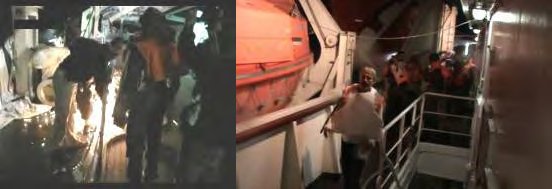
Left: Sawing iron bars (From a video found on board the ship). Right: Preparations for the confrontation: wearing ceramic vests and equipping themselves with clubs
15. The Turkish passengers who belonged to the IHH hard core (some of them masked) were divided into teams and given missions. Every team had a commander. They were all given ceramic vests and gas masks. They armed themselves with iron bars, chains and other cold weapons, and dispersed throughout the upper deck on the roof and close to the sides of the ship to prevent anyone from boarding. Some operatives secured the stairs. IHH lead Bülent Yildirim briefed his operatives, saying “Make a human chain and throw the fighters back into the sea with chair and [iron] bars.”
16. One of the passengers described the events as follows: “At 1930 hours there was a meeting to give [final] orders to the security teams for urgent intervention. Orders were given about how to put on life belts, how to put on gas masks and most important, how to act if there was Israeli intervention or an attack. After the meeting the heads of the teams along with their operatives went to secure the sectors. We were responsible for the upper aft sector of the second deck on the starboard side. We were supposed to deploy for defense. How? Only with sticks and bottles, apparently this is how glass bottles should be used. And life belts, [but] there weren’t enough for everyone…” (See additional statements in the Appendix).
Weapons Improvised during the Voyage, Especially before the IDF Took Control of the Boat
17. Much of the cold weaponry of the hard core of IHH operatives was prepared during the voyage, especially during the last hours when the ships were hailed and the boarding began. The weapons were prepared from objects available on board the ship, including:
A. Iron bars: Iron bars were sawn off the ship’s railings with the disks brought on board. About 100 were prepared.
B. Wooden clubs: Clubs were prepared from available items. About 50 clubs were improvised, in addition to standard clubs which were brought on board, hidden in rolled-up blankets.
C. Metal chains: The cutting disks were also used to prepare lengths of chains from deck equipment.
D. Axes: Axes were taken from fire extinguishing stations around the ship. About 20 axes were found.
E. Knives: 200 knives of various lengths were collected from around the ship. Most of them were taken from the kitchen and cafeterias, in addition to knives brought on board.
F. Hammers and other tools: Tools belonging to the ship were also taken. Anything that could be a weapon was used. Sponges were removed from paint rollers, which were used as improvised clubs.
G. Screw nuts: IHH operatives scattered hundreds of screw nuts on deck to impede IDF progress.
H. Broken bottles: According to the statements of passengers, bottles were broken to be used as weapons.
I. Other improvised weapons:
Appendix
Statements regarding the violence employed against IDF forces on the Mavi Marmara
Computer Files
1. An article in Turkish was found by Adham Őzkaze from the Turkish newspaper The World Bulletin (Dünya Fayfafi) entitled “Mavi Marmara is ready to resist (Mavi Marmara direnise hazir).” It stated that the operatives aboard the ship were planning “civil resistance” for the IDF and that their spirits were good, they were singing resistance songs, reading from the Qur’an and praying. It also stated that the operatives had taken it upon themselves “to defend the ship.” They were not willing to divulge their defense strategy but only said that “We will teach the Israelis a lesson they won’t forget and the Israeli army will be humiliated before the eyes of the entire world.”
Passengers’ diaries
2. The following are excerpts from passengers’ diaries:
A. An anonymous journal: “We will not allow [the Israeli forces] to board…I do not have weapons to confront them but we have surprises. The ship has been divided into teams and fronts. In the west there are two fronts. Provocation is forbidden and the resistance must be peaceful. We will resist within the ship. We have been making preparations since this evening…[Advance] notice and direction come from the Turks. The medical staff is prepared for first aid should anyone be wounded…”
B. From an anonymous diary about Israel’s possible responses to the flotilla: The writer says that “the Turks have options which will surprise the Israelis.”
C. From a diary written in Arabic: The writer reports a discussion held before the Israeli boarding. At the meeting people were divided into new squads, “including large-bodied men [i.e., thugs].” Those who participated in the discussion were briefed about how to behave if passengers were detained by the IDF:
“There is no place among us for the Zionist entity…If we are detained they are to be treated as enemies, we will refuse to sign anything, to admit to anything in a court of law [or to recognize that] entity or a trial held by that entity…”D. A personal diary in Turkish entitled “Gaza diary,” handwritten and dated May 31, 2010 [the night of the boarding]: “At 1930 hours there was a meeting to give [final] orders to the security teams for urgent intervention. Orders were given about how to put on life belts, how to put on gas masks and most important, how to act if there was Israeli intervention or an attack. After the meeting the heads of the teams along with their operatives went to secure the sectors. We were responsible for the upper aft sector of the second deck on the starboard side. We were supposed to deploy for defense. How? Only with sticks and bottles, apparently this is how glass bottles should be used. And life belts, [but] there weren’t enough for everyone… And with the help of Allah we are planning to reach the waters of the Gaza Strip at around 0700 hours. We were ready, and at around 2300 hours we began to see unidentified lights around the ship…”
E. A diary entry from a passenger about preparations for a violent confrontation: “The Israeli gunboats are approaching…All passengers have been given rescue suits in case the ship is attacked. Everyone has gone to the locations determined beforehand. A press conference was held and broadcast live. IHH leader Bülent Yildirim said that ‘it will be a war of nerves until tomorrow morning. There are people here from more than 50 countries. If people are detained, it will sully the honor of more than 50 countries. We want the entry to the Israeli embassies in Istanbul and Ankara to be locked. We will defend ourselves from here. We know there will be a price and we are willing to pay it. We will not retreat one step. Israel is behaving like a pirate in international waters. [Will] the world watch from the side?’”
A video found on board
3. A short video in Arabic showed passengers singing songs praising the intifada and anti-Semitic songs. Shouts of “Khaybar Khaybar ya Yahoud” [Note: A reference to Muhammad’s slaughter of Jewish men residing in Khaybar in the Arabian Peninsula.

Passengers aboard the ship sing militant songs and shouting anti-Israeli and anti-Jewish slogans (Al-Jazeera TV, June 2010).
Statements from Passengers Aboard the Mavi Marmara
4. Adil Yuksal, one of the passengers, said he had received orders to throw IDF soldiers into the sea if they tried to board the ship. He said that IHH operatives were responsible for organizing the ship and events on board. The operatives and other passengers carried clubs and iron bars.
5. According to the videotaped statements of two Mavi Marmara crew members, preparations for a violent confrontation with the IDF began two hours before the soldiers took control of the ship, when it was hailed by the Israeli Navy and ordered to stop. According to the statements, the atmosphere aboard the Mavi Marmara was tense and the crew noticed a gathering on the main deck. When they checked the upper deck they discovered that IHH operatives were cutting the ship’s railings with metal disks they had brought with them into lengths suitable to be used as clubs. The crew members said the activities worried them and that they tried to stop the operatives but were unsuccessful.[3]
Statements to the Turkish media
6. Interviewed by the Turkish media at Ataturk Airport in Istanbul upon arrival in Turkey, IHH leader Bülent Yildirim said that the Israeli investigators [who questioned him] asked him if the IHH operatives had attacked the IDF soldiers with iron bars and axes. He said he answered that “What I did was in self defense,” adding that “at first our comrades neutralized ten soldiers. Then we took their rifles. You are considered legally innocent if you take the weapon of a person attacking you.” He also said that they threw the weapons [they took from the soldiers] into the sea (Zaman, June 4, 2010).

Bülent Yildirim, IHH leader, describes the confrontation with IDF soldiers (Zaman website, June 4, 2010).
7. The wife of Ali Haydar Bengi, a 39-year old Turk killed aboard the ship, said in a interview that for years her husband had wanted to reach Palestine and had prayed consistently for Allah to grant him a martyr’s death. A friend said that Ali Bengi wanted to die as a shaheed. Bengi studied at Al-Azhar University in Cairo and worked at a store in the eastern Turkish city of Diyarbakir fixing telephones (Al-Hayat Al-Jadeeda, June 3, 2010).
8. Cevdet Kiliçlar was formerly a journalist. He was an IHH operative and edited the organization’s website. On a videotape photographed on board the ship he said that “while our comrades were praying in the Fatih mosque[4] [in Istanbul] in memory of our brothers killed in battle in Afghanistan, we boarded the ship [the Mavi Marmara], and therefore could not participate in the prayers. May their souls be in paradise. We also prayed on our way to our brothers in Gaza, and I pray that Allah will grant us the same auspicious ending he granted those shaheeds.”[5]
Statements of Flotilla Activists about Their Readiness
to Die as Shaheeds (Martyrs for the Sake of Allah)
1. During and after the voyage of the flotilla, the activists on board the Mavi Marmara publicly expressed their readiness to die on board the ship at shaheeds (martyrs for the sake of Allah). Their statements provided additional proof that some of the passengers, especially the hard core of IHH operatives, had prepared for a violent confrontation with the IDF forces (one operative described it as preparing for battle). Alongside the practical preparations, which included organizing the operatives and getting weapons ready, the passengers also received religious and moral indoctrination from Muslim activists and clerics, among them the Arab-Israeli sheikh Ra’ed Salah.
2. In the visual material photographed during and after the voyage of the flotilla a number of operatives confirm their desire to die as shaheeds. It is possible that some of such statements were boasts, rhetoric not necessarily meant to be acted on. However, in some cases, the statements apparently reflect a real intention to become shaheeds and some of the activists even said goodbye to their families [forever].
3. A video of interview of passengers can be accessed by clicking the link:
A. Shaza Barakat, one of the women passengers about the Mavi Marmara, interviewed by Al-Jazeera TV two days before the takeover of the ship, said “Two good things will happen: either we’ll die as martyrs or we’ll reach Gaza” (Al-Jazeera TV, May 29, 2010).
B. One of the passengers interviewed during the voyage (possibly by Iranian TV) said he wanted to die as a shaheed. He said he had participated in two previous convoys and wanted to be a shaheed and twice he had been “unlucky.” He was not, he said, afraid of [the Israeli] cartridges (Photographed aboard the Mavi Marmara).
C. Hussein Urush, a senior IHH member and one of the organizers of the flotilla, interviewed by Al-Jazeera TV a few days after the takeover that all the passengers were prepared to die as martyrs and that the goal of the flotilla was to reach Gaza or die trying (Al-Jazeera TV, June 5, 2010).
4. We have additional statements, including correspondents’ interviews. For example, a friend of Ali Haydar Bengi, a 29-year old Turkish man killed on the ship, said that Ali wanted to “die as a shaheed.” His wife said that for years he had prayed to Allah to let him die as a martyr.
(Video File No. 1)
httpv://www.youtube.com/watch?v=NOvxNSlmMQU
Notes:
[1] Follow-up of June 7, 2010 ITIC post “IHH Preparations for a Violent Confrontation with IDF Soldiers.”
[2] Khaybar was a settlement in the Arabian Peninsula conquered by Muhammad and his supporters in 628 AD. It was accompanied by the slaughter of hundred of Jews and those who surrenders were forced to pay a high tax to the Muslims. The battle of Khaybar became a symbol of Muslim conquest and especially of the defeat of the Jews at the hands of Muslims, and is used as a militant slogan against the Jews by Islamic elements, among them Hamas.
[3] For further information and the videotaped statements of the crew members, see the June 9, 2010 ITIC post, “Video Recordings of Statements from Mavi Marmara Crew Members.”
[4] The mosque is named for the conqueror of Istanbul, Mehmet the Second. It is identified with radical Islam.
[5] Internethaber.com.



 RSS
RSS

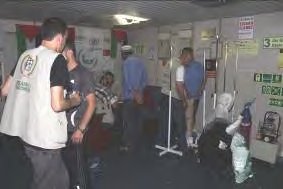

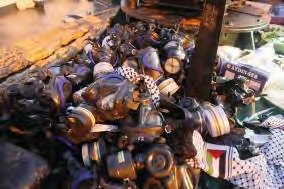


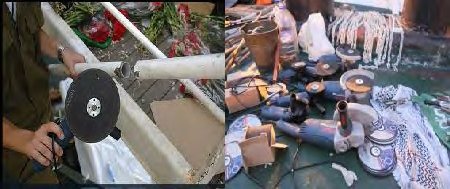
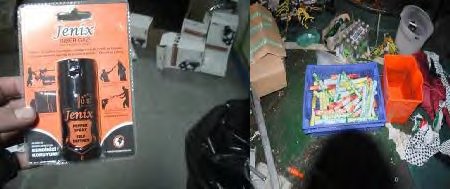



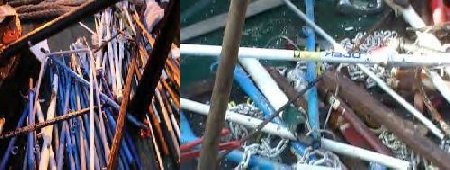
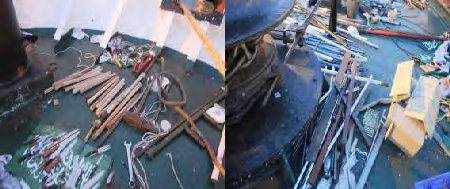
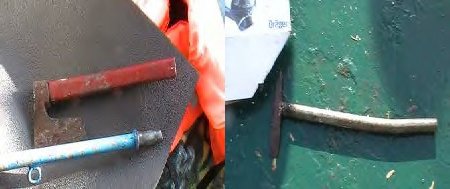
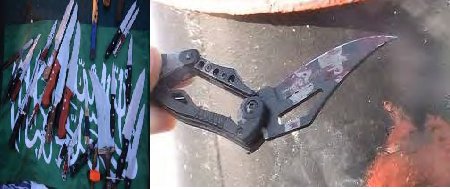
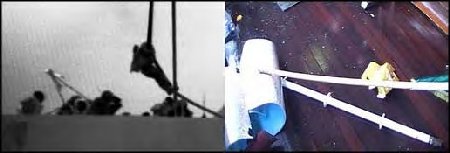



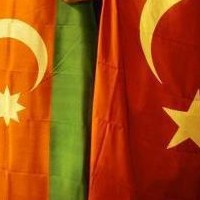
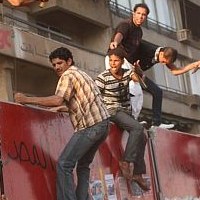





The Violent Intentions of the IHH Operatives On Board the Mavi Marmara #israel #gaza #flotilla #turkey http://j.mp/akCntR
RT @CrethiPlethi: The Violent Intentions of the IHH Operatives On Board the Mavi Marmara #israel #gaza #flotilla #turkey http://j.mp/akCntR
RT @CrethiPlethi: The Violent Intentions of the IHH Operatives On Board the Mavi Marmara #israel #gaza #flotilla #turkey http://j.mp/akCntR
[…] This post was mentioned on Twitter by Elisabeth, Crethi Plethi. Crethi Plethi said: The Violent Intentions of the IHH Operatives On Board the Mavi Marmara #israel #gaza #flotilla #turkey http://j.mp/akCntR […]
See the oustanding documentation AGHET made by Eric Friedler about the truth of the Armenian Genocide, with many proofs, long time hidden in order not to harm Turkey. The documentation was shown twice on two notable German TV stations in April this year and will be shown again in September. This is a very great sign as it’s a German production although it depicts the complicity of Germany (= Turkey’s Ally) in the Armenian Genocide.
PLEASE TAKE SOME TIME, WATCH IT AND SPREAD THE LINK.
––––––––––––––––––––––––––––––––––––––––––––––––––
http://www.youtube.com/view_play_list?p=B4306054D5680A18
––––––––––––––––––––––––––––––––––––––––––––––––––
THANK YOU.